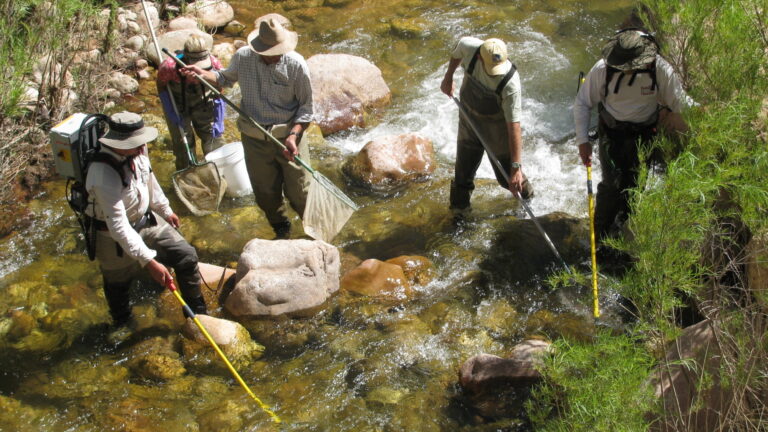Too Much of a Good Thing?
Climate warming and water overallocation may lead to new warmwater fish invasions that threaten the viability of Grand Canyon’s native fishes.

Despite dramatic changes to the aquatic ecosystem owing to invasive fish introductions and the construction and operation of Glen Canyon Dam, Grand Canyon National Park (GRCA) currently serves as a stronghold for endemic Colorado River fishes. Declines in native fishes initially occurred following introductions of invasive fishes that began more than 100 years ago and proliferation of cold water predators that thrive in the colder, more stable post-dam era—conditions that also limited native fish reproduction (Figure 1a).
Colorado River native fishes require seasonally warm water for eggs to incubate, hatch, and survive. Fifteen large dams that make up the Colorado River Storage Project also fragment migratory routes (Figure 2). Long-distance migratory species like Colorado pikeminnow (Ptychocheilus lucius) were lost from Grand Canyon, as was the bonytail (Gila elegans), and roundtail chub (Gila robusta). Nonetheless, spawning habitat in tributaries sustained important remnant populations of humpback chub (Gila cypha), flannelmouth (Catostomus latipinnis), and bluehead (C. discobolus) suckers.
Conditions limiting native fishes in the past have improved over the past decade in the Colorado River. Endangered razorback sucker (Xyrauchen texanus) was considered extirpated in the 1990s, until targeted monitoring rediscovered evidence of spawning in Grand Canyon in 2014. Increases in native fish populations have been documented in scientific publications—native fishes now numerically dominate most of Grand Canyon’s flowing habitats. Positive changes in the fish community were attributed to successful conservation actions to control invasive trout and translocate humpback chub to tributaries, and because of recent warming of dam discharge. Warmer water is being drawn through Glen Canyon Dam as Lake Powell levels decline (Figure 1a & 1b), creating suitable spawning habitat for native fish in the Colorado River in western Grand Canyon where the humpback chub population expanded. Lake Mead levels have also declined, transforming 125 km (~ 78 miles) of the former lake into riverine habitat less suitable for introduced predatory sport fishes. Regardless, profound change may be on the horizon as new threats emerge with continued declines in Colorado River flows and climate change. The question remains whether positive changes in the fish community are short-lived.
As reservoir water storage in the Colorado River basin has declined due to a complex set of circumstances related to water overallocation and climate change, warmer waters from the epilimnion layer (the layer of water on a lake that is closer to the surface during warm months) of Lake Powell are being discharged through Glen Canyon Dam during summer months (Figure 1 & 3b). In contrast to current conditions, when Lake Powell was near its water storage capacity (approaching 3,700 feet in elevation), colder hypolimnetic water (water deeper within the lake under the epilimnion layer) with lower dissolved oxygen content that is less suitable for warmwater fish was discharged through the Dam (Figure 2a). These colder conditions had been the norm after Lake Powell reached capacity in the 1980s, continuing until the mid-2000s. Native fishes declined in the Colorado River when the reservoir was near capacity, invasive trout thrived in the cold clear waters, and warmwater invasive predatory fishes were kept at bay.
Since about 2005, Lake Powell water storage declined to a level where warmer surface waters of the epilimnion began to be passed through the dam (Figure 1a & 1b, Figure 3b), which also led to suitable temperatures for native fish reproduction in the Colorado River downstream. As of March 2022, Lake Powell was approaching a critically low level not seen since 1968—an elevation where the turbine intakes are more in line with the epilimnion where the highest number of invasive warmwater fishes are found in Lake Powell during summer (Figure 3b). Projections released by the Bureau of Reclamation (Reclamation) and predictive modeling conducted by researchers at Utah State University suggest continued future declines in Colorado River reservoir levels with human water use in the Upper Basin and shrinking Rocky Mountain snowpack due to climate change. Once the lake level drops below 3,525 feet, Reclamation may determine that a switch to discharging hypolimnetic (cold) water through the deeper bypass tubes may be necessary to protect the Dam’s infrastructure—ultimately no hydroelectric power could be produced at elevations below 3,490 feet (Figure 3c). Further reservoir declines could again result in warmer surface waters discharged through the deeper bypass tubes (Figure 3d). Finally, if declines continue to 3,474 feet (bypass tube elevation), flows through the dam could be limited to run-of-the-river discharge during baseflows approximately equal (e.g., minus evaporative losses from the Lake, etc.) to inflows into Lake Powell from the Colorado River, the San Juan River, and other tributaries. Maximum discharge through the bypass tubes is 15,000 cubic-feet-second (cfs) when the reservoir is above 3,490 feet (“minimum power pool”), but discharge capacity may decline to < 4,000 cfs as Lake elevations approach the bypass tubes.
The most dramatic change to Grand Canyon’s native fish community could occur if invasive warmwater predators become established. Continued declines in reservoir levels that may maintain conditions suitable for native fish spawning are also expected to increase the likelihood of invasive warmwater predators passing through the Dam—a prospect more likely depending on reservoir elevation (Figure 3). Warmwater predatory sportfish like smallmouth bass (Micropterus dolomieu; Figure 4) and green sunfish (Lepomis cyanellus) are common in the warm surface layers of Lake Powell but have been rare in Grand Canyon in the post-dam period. Smallmouth bass, native to the Great Lakes, Red River, and Mississippi River basins, are considered among the highest risk invasive species threatening Colorado River native fishes. For example, in the Upper Colorado River Basin’s Yampa River, a combination of drought and low river flows facilitated high escapement from headwater reservoirs and proliferation of smallmouth bass that led to the extirpation of humpback chub. Approximately $2 million per year (~$30 million total) is spent suppressing populations of smallmouth bass and other predators to protect endangered fishes in the Upper Colorado River Basin. Like humpback chub, smallmouth bass can spawn when temperatures exceed 16°C/61°F (Figure 1a); however, sufficient numbers of adult fish need to be present for successful reproduction and population establishment to occur. Suitable spawning habitat for smallmouth bass may exist in a slough downstream of Glen Canyon Dam, in slow-velocity backwater habitats, and in and near tributaries like the Little Colorado River, Kanab Creek, or others, but reservoir declines could result in suitable conditions throughout the mainstem. In 2021, summer temperatures exceeded the minimum 16°C/61°F threshold throughout Grand Canyon (Figure 1a), and warmer conditions may be on the horizon for 2022 (as in Figure 3b). We expect that if smallmouth bass and other predators become established, it could be a point of no return for humpback chub and other native fishes in Grand Canyon.
The rate of reservoir level decline and the probability of warmwater predatory fish passing through Glen Canyon Dam are difficult to predict, and factors that increase the risk of live passage through the turbines and into Grand Canyon are not well understood. Biologists have suspected that small numbers of warmwater fish have been passed through Glen Canyon Dam even at higher lake levels for years. Recent increases in the number of juvenile green sunfish below the Dam may be an indicator of increased passage rates. Uncertainties related to the risk of invasions include the number and distribution of warmwater fishes in relation to the intakes by season, critical lake levels, or dam discharge volumes (i.e., the number of turbines and intakes in operation) that may facilitate passage, and factors that may enhance survival of fish passing through the turbines (e.g., size or species of fish). A second set of uncertainties include site-specific conditions that may facilitate reproduction in Grand Canyon, beyond minimum water temperature requirements. Fluctuating daily flows for hydropower production could limit successful nesting of some invasive species to a degree. It is also difficult to predict the minimum number adults needed (termed “propagule pressure”) for successful population establishment. Nonetheless, conditions could be ideal for smallmouth bass. River regulation by dams characterized by stable seasonal conditions lacking spring flooding may be more conducive to reproduction of invasive species that evolved in stable and predictable environments. The Grand Canyon’s aquatic habitats would also provide a longer growing season for juvenile smallmouth bass than in the Upper Basin where they are limited by cold winter temperatures. Regardless, given the history of rapid expansion of smallmouth bass and high predation rates on endangered fishes in the Upper Basin, the National Park Service (NPS) and its cooperators are discussing options for a management response, if needed, to avoid losing the largest remaining population of humpback chub on Earth.
There are some management options that may help to slow the establishment or spread of invasive predatory fishes, but none are inexpensive, easy to implement, or without controversy. The priority is to prevent an invasion in the first place, but many prevention options may involve maintaining higher reservoir levels or alterations of dam discharge—options that may be difficult or impossible to implement due to water availability and delivery requirements. In the Upper Basin, researchers from Colorado State University have developed a study plan for using dam operations to inhibit smallmouth bass reproduction in the Green River using a summer “spike flow” of cold water. Initial results of an experiment conducted by the Upper Colorado River Endangered Fish Recovery Program appear promising, and predictive modeling suggests reductions in reproduction may more successfully suppress the population than mechanical removal of older individuals. A similar cold spike flow out of Glen Canyon Dam could be possible with the current lake levels and use of discharge through the bypass tubes (before conditions decline to those depicted in Figure 3b).
Some management options that may not require changes to Dam operations are included in the NPS Comprehensive Fisheries Management Plan. For example, the GRCA Native Fish Ecology and Conservation Program (NFEC), with support by Reclamation and Grand Canyon Conservancy, has successfully used mechanical removal techniques (e.g., electrofishing) in tributaries to suppress invasive brown trout (Salmo trutta) and rainbow trout (Oncorhynchus mykiss) that threaten native fishes. Mechanical removal of smallmouth bass would be much more difficult and labor intensive on the mainstem Colorado River but could be applied as a rapid response in either tributaries or the mainstem if spawning is detected. An additional option could be to continue to attempt to establish and maintain refuge populations of humpback chub and other native species in tributary habitats upstream of barriers preventing invasion by predators from the Colorado River (e.g., Havasu and Shinumo creeks). Unfortunately, predictive modeling of brown trout populations in Glen and Grand canyons conducted by researchers with Utah State University and the NFEC program suggests brown trout will likely persist in tributary refuges like Bright Angel Creek even as the mainstem warms. Conditions expected once bypass discharge is necessary (Figure 3c) would again facilitate the proliferation of brown trout and cold-water invasive species.
Many Indigenous tribes hold all aquatic life sacred, regardless of its native or introduced status, and it is hoped that no additional invasive fish removal is necessary for a new warmwater invader like smallmouth bass.
Author: Brian D. Healy
Figure 1, Temperature data source: USGS gaging station number 09380000
Figure 1, Lake Elevation data source: Bureau of Reclamation
Figure 2, Colorado River basin and its dams map image: U. S. Bureau of Reclamation (https://printablemapforyou.com/colorado-river-map-texas/colorado-river-storage-project-uc-region-bureau-of-reclamation-new-colorado-river-map-texas/)
Figure 4, Adult humpback chub captured in Havasu Creek: NPS/Amy Martin
Figure 4, Humpback chub and smallmouth bass illustrations: Courtesy © Joe Tomelleri



